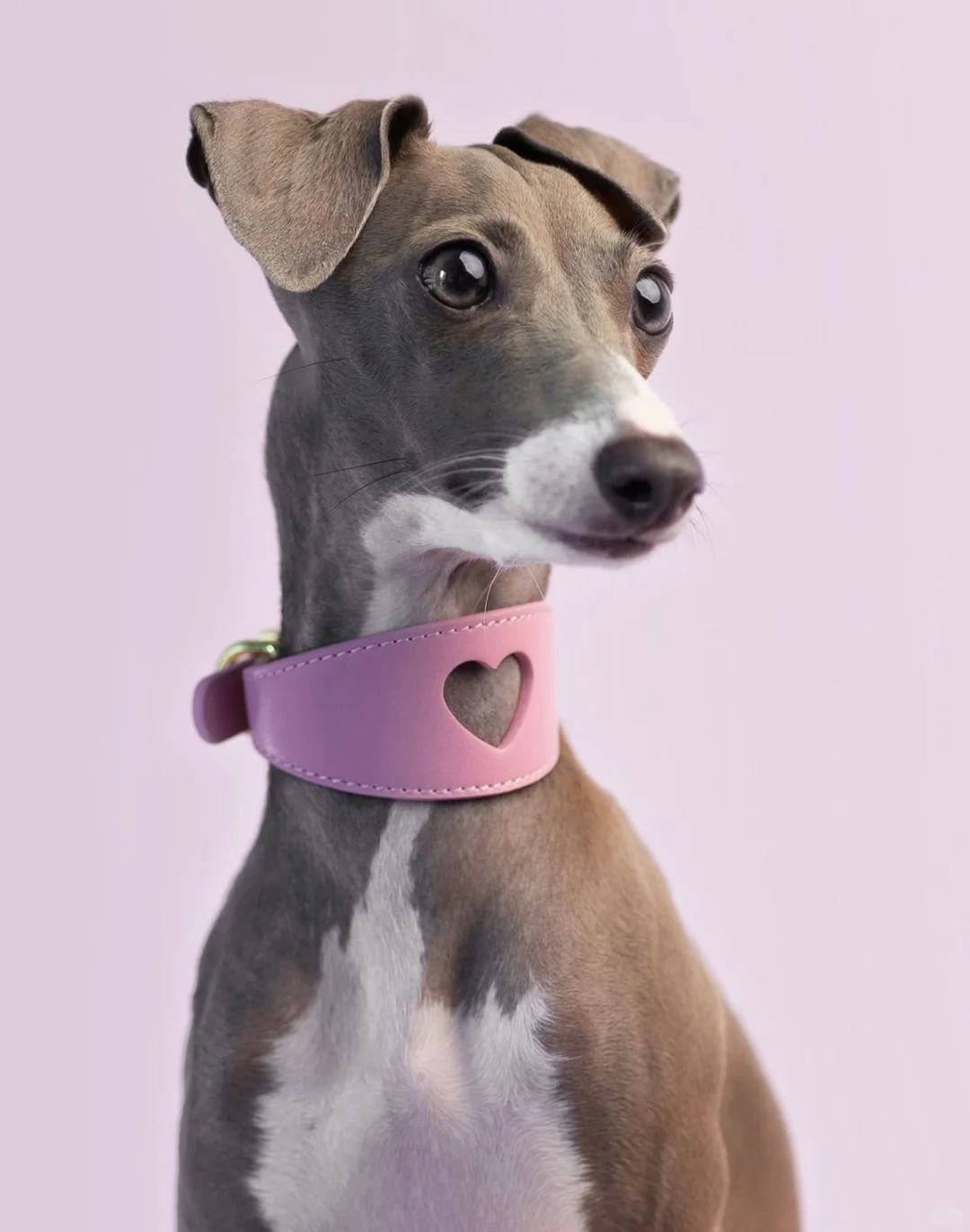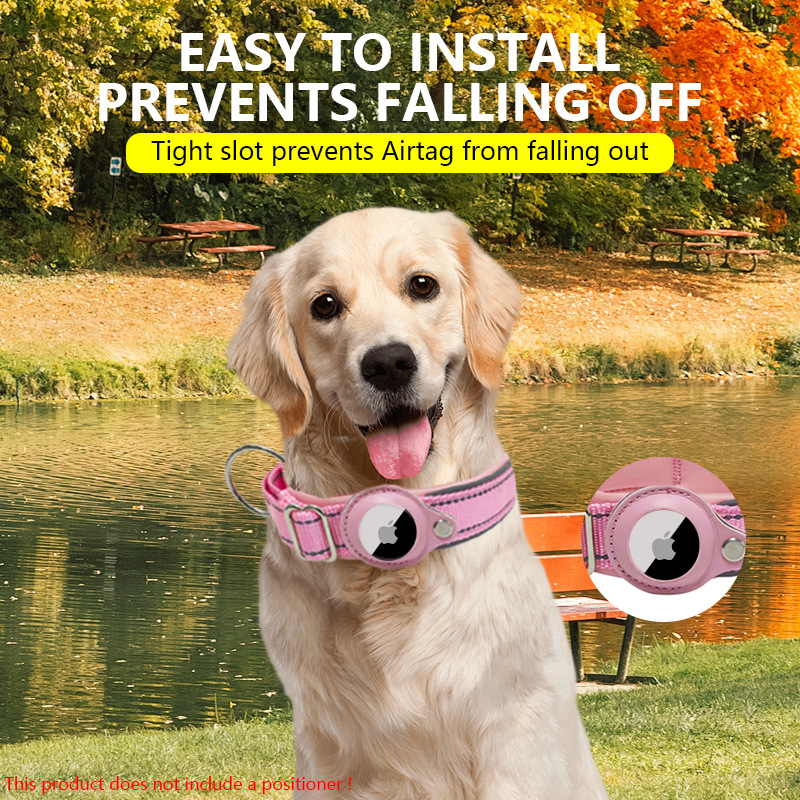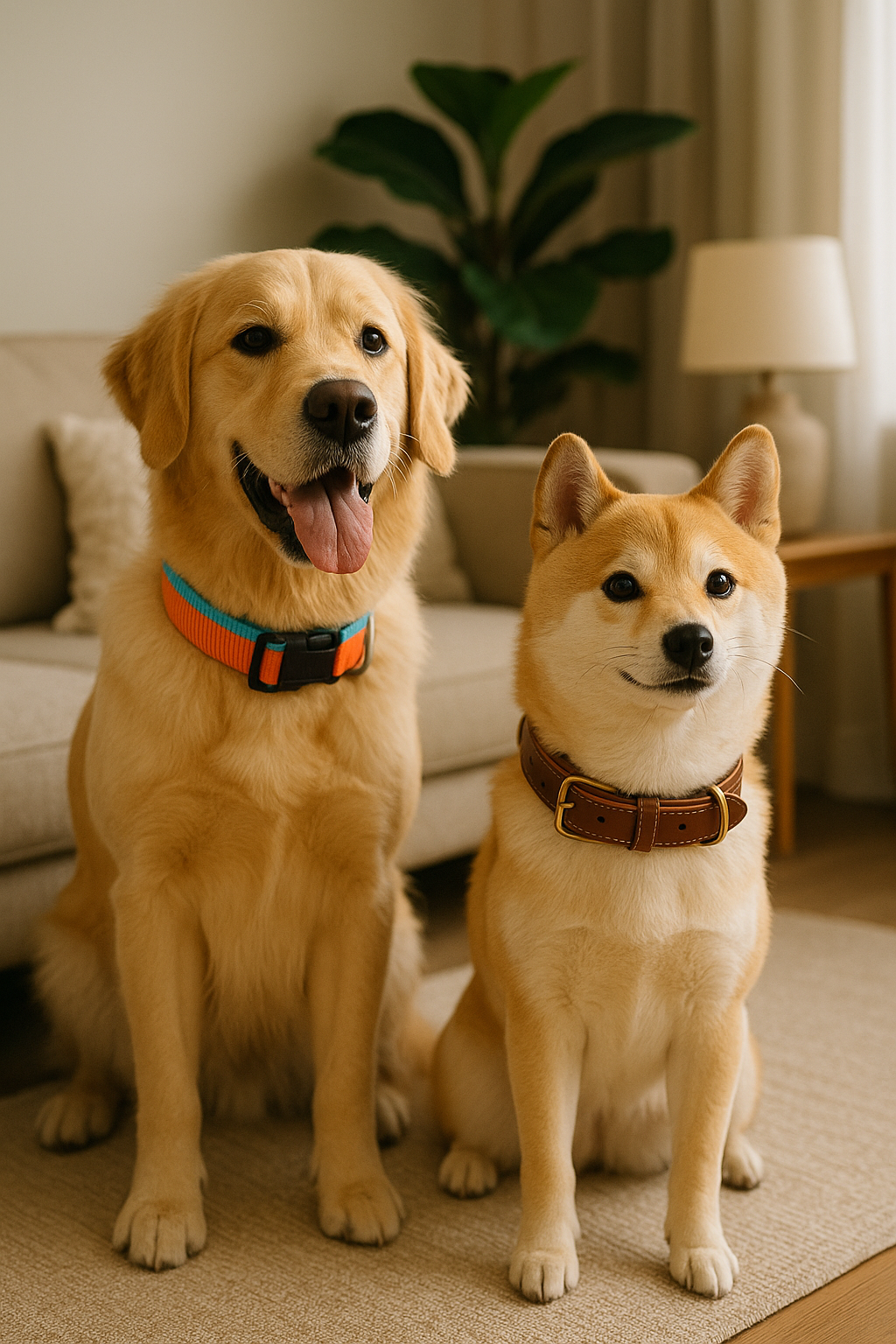Choosing the right dog collar isn’t just about style — it directly affects your dog’s comfort, safety, and even long-term health. In 2025, one of the most common questions pet owners ask is: Should I get a nylon dog collar or a leather dog collar?
Both materials have their loyal fans. Leather dog collars are praised for their durability, timeless look, and the way they mold to a dog’s neck over time. On the other hand, nylon dog collars win points for being lightweight, affordable, washable, and available in endless colors and designs.
But which one is actually better for your dog? The answer depends on your pet’s lifestyle, activity level, and your own maintenance preferences. "As a dog owner myself, I've spent years testing gear on my pack. I know the frustration of a frayed nylon collar and the satisfaction of a perfectly broken-in leather one. Let's dig into which one is truly right for your best friend."

Leather dog collars are often seen as a premium choice in the pet accessory market, thanks to their durability, comfort, and timeless appeal. But while they offer unique benefits, they also require more care and may not suit every dog.
1. Exceptional Durability
High-quality leather can last 5–10 years with proper care, far outlasting nylon collars that usually last 2–3 years. A 2024 PetSafe Market Survey found that 70% of leather collars were still in use after 5+ years.
2. Comfort and Fit
Leather softens over time and molds to the dog’s neck, creating a custom fit. A study in the Journal of Veterinary Science (2023) reported that dogs wearing leather collars experienced 23% fewer cases of skin irritation compared to synthetic collars.
3. Premium Aesthetic Appeal
Leather’s natural grain and sheen give it a luxury, timeless look. Statista (2025) noted that over 40% of premium pet accessory buyers prefer leather for its high-end appearance and craftsmanship.
4. Moderate Breathability
Compared to fully synthetic materials like PVC or PU, genuine leather allows some airflow, reducing excessive heat buildup during long wear.
5. Versatile Styling
Leather collars come in various colors and finishes, from classic black and brown to designer looks. They’re often chosen for formal settings, dog shows, or coordinated owner-pet accessories.
1. High Maintenance
Leather absorbs dust, hair, and odors easily. It requires special cleaning and conditioning, unlike nylon which is machine washable. Over 60% of leather collars are replaced within 3 years due to cracking or poor maintenance (Pet Product Care Research, 2024).
2. Limited Performance in Humid or Hot Climates
While more breathable than PVC, leather doesn’t ventilate as well as nylon. In humid environments, it may trap moisture and cause discomfort or irritation, especially for sensitive dogs.
3. Heavier Weight
Thicker leather collars are heavier than nylon, making them less suitable for puppies or dogs under 5 kg (11 lbs).
4. Vulnerability to Weather
Leather can fade, warp, or grow mold when exposed to rain, sunlight, or humidity. A Journal of Pet Gear Materials (2023) study found leather lost 25% of tensile strength after 90 days in high-humidity conditions.
5. Odor Retention
New leather often carries a strong smell, and over time it can absorb sweat or outdoor odors. Deodorizing leather is more difficult than washing nylon.
Leather dog collars are ideal for premium markets, style-conscious owners, and dogs with sensitive skin, provided the owner is willing to invest in regular care. But for humid climates, small breeds, or highly active dogs, the maintenance challenges and heavier weight may outweigh the benefits.

Nylon dog collars are among the most popular choices worldwide thanks to their affordability, lightweight build, and wide variety of designs. However, they also come with certain limitations that pet owners should be aware of.
1. Affordable & Widely Available
Nylon collars are budget-friendly, typically priced between $20–40, compared to leather’s $45–120. This makes them a practical choice for families with multiple pets or for those who want to switch collars regularly.
2. Lightweight & Comfortable
The soft nylon webbing is lightweight, making it especially suitable for small dogs, puppies, and highly active breeds. According to a 2024 PetSafe Consumer Survey, 82% of pet owners choose nylon collars for their dog’s first collar because they are easy to wear and adjust.
3. Weather-Resistant & Easy to Clean
Nylon performs well in wet or humid environments. It dries quickly, resists mildew, and can be machine washed. This makes it ideal for dogs who swim, hike, or live in rainy climates.
4. Safety & Functional Features
Modern nylon collars often include reflective stitching, quick-release buckles, and customizable embroidery (e.g., phone number or name). These features add safety and convenience that leather rarely provides.
5. Style Variety
Nylon collars come in hundreds of colors, prints, and seasonal designs, making them a top choice for owners who want fashionable options at a low cost.
1. Shorter Lifespan
Nylon tends to fray or weaken within 2–3 years of daily use, especially for strong pullers. In lab tests (SGS Pet Product Safety Report 2024), nylon webbing lost 15% of tensile strength after 1 year of heavy use, compared to leather which remained intact.
2. Skin Sensitivity Risks
Some dogs with sensitive skin may develop irritation from nylon’s synthetic fibers or dyes. A veterinary survey (2023) noted that 14% of allergic reactions in dogs were linked to synthetic collars.
3. Not as Premium in Appearance
While nylon offers variety, it lacks the high-end, classic look of leather. For show dogs or formal events, nylon may appear less elegant.
4. Odor Retention in Heavy Use
Although washable, nylon can trap odors if not cleaned regularly, especially after exposure to mud, sweat, or seawater.
5. Less Eco-Friendly
Most nylon collars are made from petroleum-based materials. While recycled nylon options (like ECONYL®) are emerging, they are still less common than standard nylon products.
Nylon dog collars are perfect for active dogs, puppies, and budget-conscious owners. They shine in versatility, comfort, and low maintenance. However, for long-term durability, premium style, or dogs with sensitive skin, nylon may fall short compared to leather.
Want to see how nylon vs. leather dog collars stack up against each other? This detailed analysis will help you understand exactly what you're getting with each choice.
Feature / Factor | Nylon Dog Collars | Leather Dog Collars |
Durability | Lasts 2–3 years; may fray with strong pullers | Lasts 5–10 years with proper care; strong but needs maintenance |
Weight & Comfort | Very lightweight, ideal for puppies & small dogs | Heavier, best for medium & large dogs; molds to neck over time |
Maintenance & Cleaning | Machine washable, dries quickly, low upkeep | Needs special cleaners & conditioning; not waterproof |
Weather Resistance | Excellent in rainy or humid climates; mildew-resistant | Sensitive to moisture & sunlight; can fade, warp, or grow mold |
Style & Appearance | Wide range of colors, patterns, reflective designs | Classic, luxury look; limited colors, develops patina over time |
Skin Sensitivity | May cause irritation for dogs with sensitive skin | Hypoallergenic; gentler on sensitive skin |
Price Range | $20–40 (budget-friendly, easy to replace) | $45–120 (premium accessory investment) |
Best For | Small dogs, puppies, active or water-loving dogs | Sensitive-skin dogs, show dogs, premium style owners |
Eco-Friendliness | Some eco options (recycled nylon like ECONYL®) | Natural material, biodegradable, but less water-resistant |
Takeaway
1. Nylon dog collars are affordable, lightweight, and perfect for active, water-loving, or small dogs.
2. Leather dog collars are durable, stylish, and well-suited for premium markets, sensitive-skin dogs, and long-term use, but they require regular care.
All the theory is great, but nothing beats a real-world example. My Golden Retriever, a total water fanatic, lives in his nylon collar. It's the perfect match for him—it gets soaked during our lake trips and is dry an hour later, without ever getting that damp, musty smell. But it was a completely different story for my friend's French Bulldog. He developed an irritated red ring around his neck after just a few days in a nylon collar. Switching to a soft, natural leather collar cleared it up completely.

This little story perfectly illustrates the point: choosing the right collar is about so much more than just looks. Your dog’s activity level, the climate you live in, skin sensitivity, and even breed type all play a crucial role. Here’s a complete guide to help you decide:
l Collars → Lightweight and flexible, nylon is perfect for active or outdoor-loving dogs that run, swim, or play often.
l Best Suited Breeds: Golden Retrievers, Labradors, Border Collies, and other sporty dogs.
l Leather Collars → More suitable for calmer, well-trained, or show dogs. Over time, leather softens and molds to the dog’s neck, adding comfort.
l Best Suited Breeds: Dobermans, Schnauzers, Shiba Inus. For large, strong pullers, a 3 cm wide anti-pull leather collar is recommended.
l Nylon Collars → Quick-drying and mildew-resistant, ideal for rainy or coastal regions and for dogs that love swimming.
l Extra Tip: A nylon collar with anti-friction coating can reduce wear and extend lifespan.
l Leather Collars → Perform best in dry climates. In humid or rainy environments, leather may absorb moisture, leading to warping or mold unless properly maintained with care oils (e.g., mink oil).
l Nylon Collars → Budget-friendly ($20–40), easy to wash, and simple to replace. Great for families with multiple dogs.
l Leather Collars → Premium pricing ($45–120), but long-lasting if well maintained.
l Require regular cleaning and conditioning, making them ideal for owners willing to invest time in care.
l Leather Collars → Natural and generally hypoallergenic, making them a better option for dogs prone to redness, itching, or skin allergies.
Leather Dog Collars
Pros: Durable, stylish, develops a vintage patina, doesn’t tangle long hair.
Cons: Not waterproof, prone to mold, requires regular care.
Best For: Medium-to-short coat breeds (Dobermans, Schnauzers, Shiba Inus), large dogs needing strong anti-pull support, and style-conscious owners.
Nylon / Polyester Dog Collars
Pros: Lightweight, quick-dry, colorful designs, easy to wash, affordable.
Cons: May pill with frequent friction, long-term dampness can harbor bacteria.
Best For: Sporty and water-loving breeds (Labradors, Golden Retrievers, Border Collies), puppies, and dogs in rainy or humid climates.
Takeaway
There’s no absolute winner in the nylon vs leather dog collar debate. Instead, the right choice depends on your dog’s activity level, environment, breed, and your own budget and maintenance preferences.
Go for nylon if you need something practical, affordable, and water-resistant.
Choose leather if you value style, long-term durability, and comfort for sensitive skin dogs.
If you’re still unsure which collar to choose, here’s a quick decision guide:
Puppies & Small Dogs → Nylon (lightweight, affordable, easy to adjust
Large or Strong Pullers → Leather (durable, recommend 3 cm wide anti-pull design)
Sensitive Skin Dogs → Leather (natural, hypoallergenic)
Dogs in Rainy / Humid Climates → Nylon (quick-dry, mildew-resistant)
Multi-Dog Households → Nylon (budget-friendly, easy to clean, replaceable)
Premium / Show Dogs → Leather (luxury appearance, long-term durability)
Custom Branding Needs (OEM/ODM) → Both nylon & leather available depending on brand positioning
When it comes to choosing between leather dog collars and nylon dog collars, there is no one-size-fits-all answer.
l Leather collars remain one of the most popular options. Made from high-quality genuine leather, they are comfortable, durable, and stylish. Many leather collars are even handcrafted, offering unique colors and designs to suit different preferences. However, they are not waterproof and require proper care — if exposed to rain, they should be dried immediately. Leather is best suited for medium to large dogs or owners who value premium style and long-term durability.
l Nylon collars, on the other hand, are a favorite for everyday walks and training. They are lightweight, adjustable, and easy to clean, making them especially practical for active dogs or households with multiple pets. Nylon collars are budget-friendly, come in a wide variety of styles, and can be quickly adjusted for comfort and safety.
In the end, both materials have their place. The best choice depends on your dog’s breed, activity level, and your own care preferences.
CTA
Looking for custom nylon or leather dog collars for your brand? At Minardipets, we provide OEM/ODM services with small MOQ, logo printing, and fast delivery — helping you build a pet accessory line that perfectly fits your market,contact us now